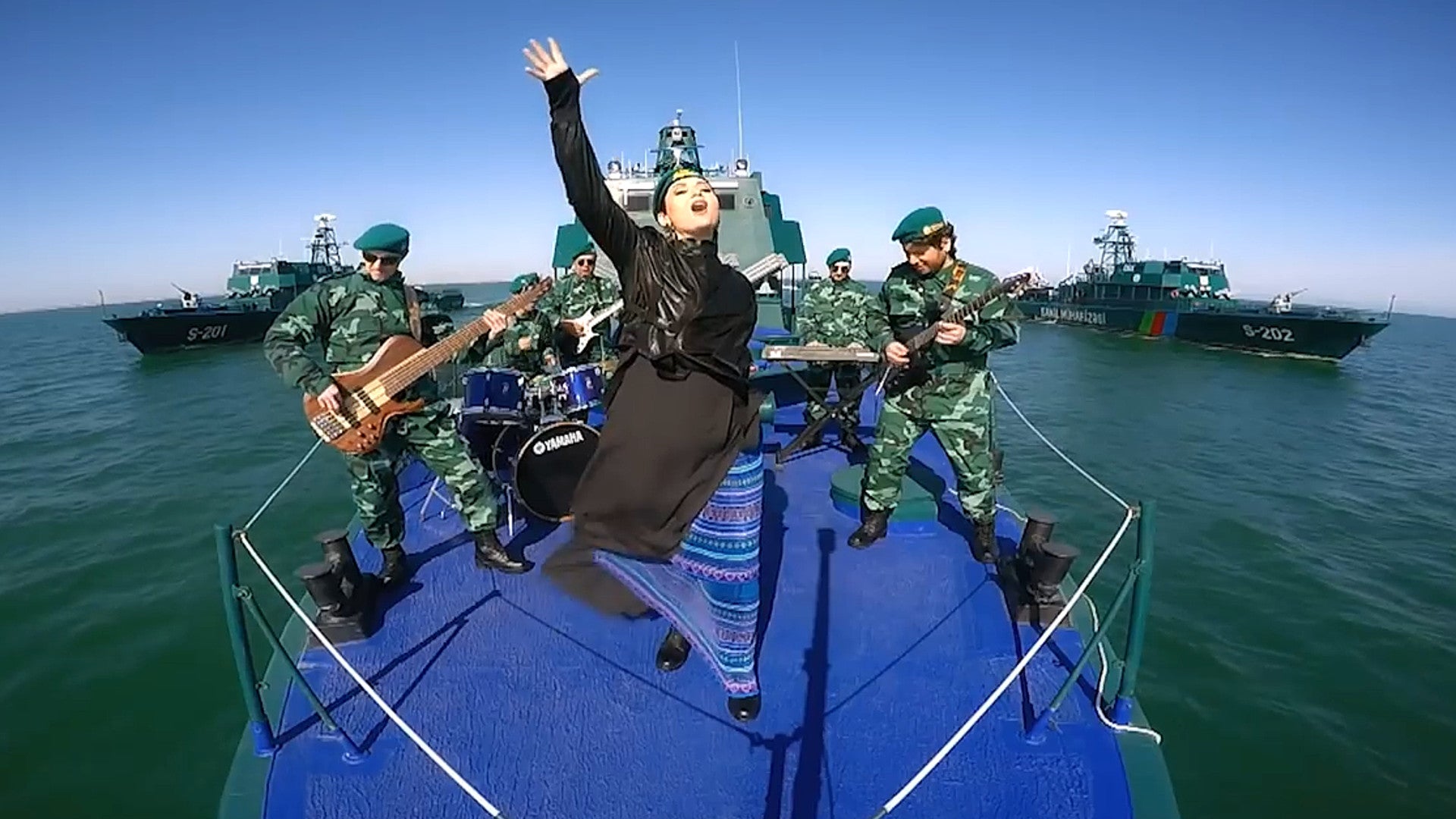The internet really has radically defined the ways military and security forces, as well as defense contractors, can promote themselves, while also giving journalists and researchers copious amounts of extra material to pore over when looking for new and interesting tidbits. Case in point, a recent and slickly produced music video from Azerbaijan’s State Border Service, featuring a former contestant on The Voice of Azerbaijan, along with a full band, performing around tanks, armed helicopters, and patrol boats. It even includes the launch of Israeli-made suicide drones.
Azerbaijan’s border guard posted the music video, titled “Ways of the Queen” and staring Narmin Karimbayova and Nur Group, on its official YouTube channel, which is a thing that most definitely exists, on April 11, 2018. Joseph Dempsey, a defense researcher with the International Insitute for Strategic Studies, was among the first to notice that, in addition to a catchy song, the full production offered an unusually detailed look at some of the small Caucasus country’s most advanced weaponry. It also prominently features clips of dictatorial President Ilham Aliyev, who has run the country since 2003, when his father, Heydar Aliyev, died.
It’s not clear whether or not all of the systems in the video belong to the State Border Service, which Heydar created by presidential decree in 2002. Previously part of the Ministry of Interior, the organization now includes ground, air, and naval forces that patrol the country’s boundaries on land and in the Caspian Sea. This gives the group a prominent role in Azerbaijan’s simmering conflict with neighboring Armenia over a disputed region known as Nagorno-Karabakh or simply Karabakh.
The music video has a visibly patriotic and nationalistic tenor, but with a pop song beat. It’s worth watching in its entirety.

Beyond the spectacle of the thing, there are a number of particular weapons worth pointing out. Most notably, briefly, beginning at the 1:54 mark in the runtime, there is a clip of a truck-mounted launcher firing an Israel Aerospace Industries (IAI) Harop loitering munition.
Both Azerbaijan and the manufacturer have largely declined to confirm publicly that the Azerbaijanis security forces have and are employing the system in combat. In April 2016, a number of the weapons reportedly struck Armenian-backed rebels in Nagorno-Karabakh during an outburst of fighting.

Here’s how The War Zone’s own Tyler Rogoway describes this system, which is an improved version of the earlier IAI Harpy suicide drone:
In the late 1990s, Israel began working on a follow-on to the Harpy. It would be a larger design that could be reconfigured for multiple uses, including attacking radars, providing both electronic and electro-optical intelligence, attacking targets of opportunity on the ground (say, vehicles). Plus, it could even be outfitted to come back home and be reused again.
Harop, with its folding wings, can be launched from a truck- or ship-mounted canister, or configured for air-launch. Once in the air, it can be operated by man-in-the-loop control or it can go about its mission totally autonomously. Either way, it can put its warhead to use, using its camera system and operator to track and engage moving targets or its radiation-seeker to sniff out and attack radar sites on its own. It can even be equipped for both missions at the same time, so that if a radar site were to go offline after a Harpy detected it, it can fly to its location and use electro-optical targeting to locate and kill it.
A huge difference between Harop and the Harpy is range and loitering time, with the modern iteration packing about double that of its simpler predecessor, or about 600 miles or six hours. That, plus the fact that it can be equipped to return home autonomously and land once its fuel runs low.
Basically, the Harop—which has the radar signature of a small bird and virtually no infrared signature whatsoever—offers an inexpensive solution for many unmanned missions in a small, transportable, and optionally reusable package. You can imagine that if you are the enemy, having dozens or even hundreds of these things roaming your countryside during a time of conflict would be pretty terrifying.
Azerbaijan, which has a tense relationship with Iran to the South, has subsequently developed strong ties with Israel and Harop isn’t the only example of Israeli-made weapons in the video. Karimbayova and Nur Group at times perform on the deck of the one of the Azerbaijani Coast Guard’s Sa’ar 62 offshore patrol vessel.
These ships have, among other things, a Typhoon MLS-NLOS missile launcher, a navalized version of the Spike NLOS missile system, which is also a prominent feature in the video. As with Harop, these weapons have a fire-and-forget mode, using dual-mode Imaging Infrared and CCD seekers, as well as a man-in-the-loop control capability. Coupled with direct and top-attack flight profiles, the weapons can hit targets on land and at sea.

Otherwise, the video primarily features more mundane equipment. The State Border Service’s BTR-70 or -80 8×8 wheeled armored personnel carriers, Otokar Cobra 4×4 light armored vehicles, and unarmed Land Rovers, as well as a small number of T-72 tanks, are all featured. On top of the Sa’ar 62s, there are clips showing more or less the Coast Guard’s entire fleet, including smaller Soviet-era Stenka– and Zhuk-class patrol boats.
At other points in “Ways of the Queen,” the organization’s fleet of Mi-17 Hip armed transport helicopters fire rockets and drop troops off. Don’t blink, or you might miss border guards firing South African-designed Milkor MGL six-shot revolving 40mm grenade launchers and the obscure Soviet-era APS underwater assault rifle at 0:22 and 1:48 in the video’s runtime, respectively.
All told, it’s definitely worth less than five minutes of your time to watch Karimbayova’s ode to Azerbaijan’s State Border Service. Take a look and feel free to let us know if you see anything else notable in the comments below.
Contact the author: jtrevithickpr@gmail.com
